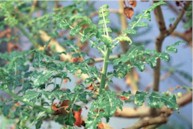

![]()
![]()
 |
Boswellia serrata |
Some years ago, Gabriela Wagener-Ewald, a practitioner in Nuremburg, told me that German doctors and naturopaths were getting excellent results—in ten days or less—with an Indian herb, Boswellia serrata, in the treatment of brain tumors. I have been cautiously passing on this information "for what it is worth," knowing that people with such tumors suffer serious changes in function due to the pressure on the brain, a problem that is usually aggravated by edema.
Boswellia serrata is a type of frankincense, one of the gifts brought by the Wise Men to celebrate the birth of Jesus. The frankincense used in the West is usually Boswellia carteri, a Somalian species whose properties have not been studied nearly as much as one might think given the Biblical references.
At the Bioneers Conference (in 2000), a man told me that his father has eight tumors. He wanted to know if there is anything at all that would help his father. He went on to do some internet research and to hire someone to translate some of the German language material. Gabriela's report is evidently well supported by research in Europe.
Prof. Thomas Simmet has researched Boswellia serrata on astrocytomes, a tumor noted for its propensity to metastasize. Prof. Simmet's background is in pharmacology, and he suggests that the boswellic acids reduce inflammation. I was familiar with this research because boswellia is used extensively in Ayurveda to reduce the symptoms of arthritis. Prof. Simmet proposes that boswellia inhibits the production of an enzyme that causes the leukotriene production associated with inflammation. In laboratory tests, Prof. Simmet observed that the more malignant the tumor, the more leukotrienes it produces. This seems to perpetuate a cycle of almost unstoppable growth.
Working with a neurosurgeon, Michael Winking, 25 patients were administered a dry extract of boswellia for one week. The tumors were then surgically removed. About half the patients had such significant regressions that the tumors had all but disappeared. They used a dosage of 800 mg. three times a day.
CT after Boswellia [10 weeks] CT images compliments of Dr. Dana Flavin-Koenig
Foundation for Collaborative Medicine and Research
At the university hospitals of Bochum and Giessen, patients with gliome tumors were administered somewhat higher dosages of Boswellia serrata, 3600 mg. per day. Within only a few days, many symptoms associated with brain tumors, such as headaches and lameness, were greatly lessened. While much of this effect might be more related to the reduction in edema than to the regression of the tumor, swelling and the resultant pressures are serious side effects of malignancy that impact the quality of life. The reports of these trials are preliminary and researchers are unwilling to speculate as to the long-term results and whether or not tumor growth is arrested.
I have long been familiar with Boswellia carteri and more recently Boswellia frereana came into my life. Both are lovely and can be used to make incense. All the different varieties of frankincense have a wonderful aroma and spiritual quality, but Boswellia serrata is more subtle than the frankincense used ceremonially in the West. Boswellia serrata is also very aromatic, but the difference is something like jasmine and stephanotis. Jasmine is powerful and grabs attention whereas stephanotis wafts more delicately and lingers elegantly on the senses.
Anecdote:
Soon after hearing about Boswellia serrata and the research conducted in Germany, I decided to experiment on a dental abscess that suddenly flared up. I therefore took some capsules; the following day, the inflammation was about half what it was before taking the Boswellia serrata.
Note: Boswellia serrata comes in many different forms. We carry the bulk powder which you can either take with food or encapsulate as well as the alcohol extract and tablets. We also have the essential oil. of both the Indian Boswellia serrata and Somali frankincense. With the oil, you can consider putting a single drop into a carafe of water and sipping this throughout the day.
God bless!
Dr. Eli G. Jones, Eclectic Physician
![]()
Much of the material on this site is historic or ethnobotanical in origin. The information presented is not intended to replace the services of a qualified health care professional. All products discussed on this site are best used under the guidance of an experienced practitioner.
We encourage patients and their friends and family to avail themselves of the information found on the Internet and to share their discoveries with their primary care practitioners. If there are questions about the suitability of a product or strategy, please have your practitioner contact the web hostess.
We are interested in feedback, clinical data, suggestions, and proposals for research and product development. While we naturally hope for the happiest outcome in all situations, the authors of this web site, webmaster, server, publishers, and Sacred Medicine Sanctuary are not responsible for the success, failure, side effects, or outcome of the use of any of the information or healing strategies described on this site.
Sacred Medicine Sanctuary
Copyright by Ingrid Naiman 2000, 2001, 2005
*The information provided at this site is for informational purposes only. These statements and products have not been evaluated by the Food and Drug Administration. The information on this page and these products are not intended to diagnose, treat, cure, or prevent any disease. They are not intended to replace professional medical care. You should always consult a health professional about specific health problems.





